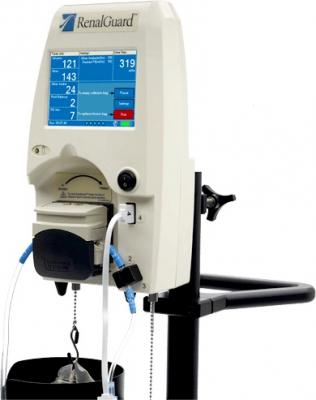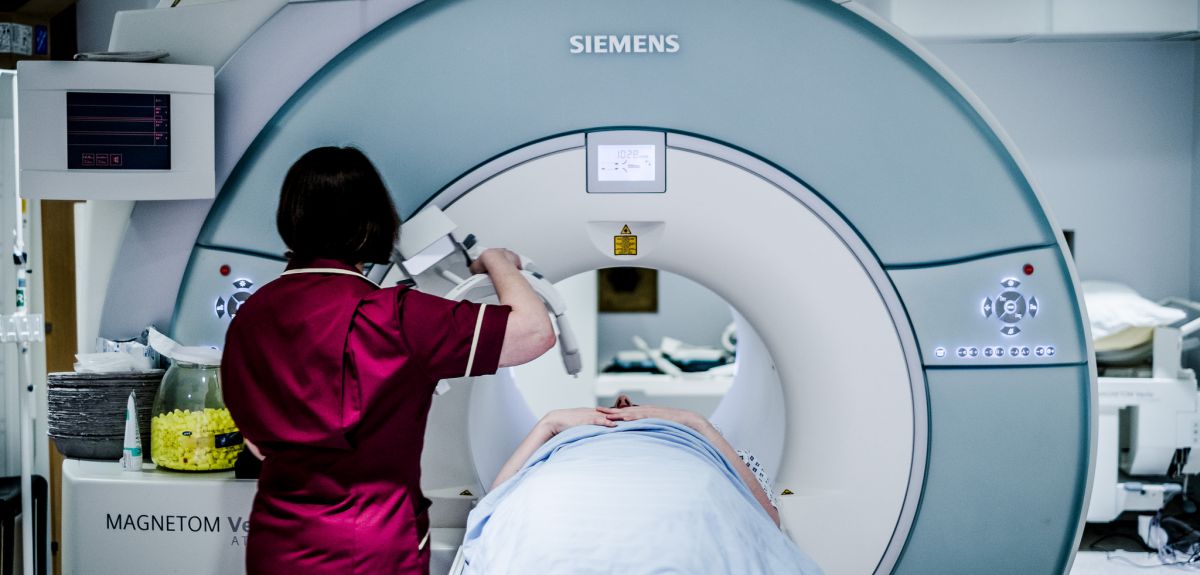
Novel fluid replacement and balance system featured in two presentations at Devices in Heart Failure Congress
RenalGuard Solutions Inc. reported positive results from a first-in-man feasibility study focusing on a novel use of the RenalGuard System to manage fluids during diuretic therapy in congestive heart failure patients suffering from fluid overload. The results were recently presented at the annual Devices in Heart Failure (D-HF) Congress, Dec. 15-16 in Berlin, Germany, by Prof. Piotr Ponikowski, M.D., of the Wroclaw Medical University, Poland, and Prof. Felix Mahfoud, M.D., of the Saarland University Hospital, Homburg, Germany.
The presentation reviewed the ways in which current treatment strategies for hospitalized patients with heart failure remain inadequate. Annual hospitalizations for heart failure exceed 1 million in both the United States and Europe, and more than 90 percent are due to symptoms and signs of fluid overload. Recurrent fluid overload in heart failure patients has uniformly been associated with worse outcomes independent of age and renal function; 25 percent of hospitalized patients will be re-hospitalized within three months, with a one-year mortality rate of 26 percent.
The presenters also identified the drawbacks of diuretic therapy, the cornerstone therapy for fluid overload, which acts primarily by inducing fluid loss. An individual patient’s response to diuretic therapy is often variable and unpredictable. If the patient sees excessive urine output due to the diuretic, this rapid fluid loss can induce a condition termed “diuretic resistance,” which blunts the continued function of diuretics and may result in acute kidney injury.
Originally developed for the treatment of contrast-induced acute kidney injury (CI-AKI), RenalGuard Therapy offers a potential solution to improve the impact of diuretic therapy in the treatment of fluid overload in heart failure patients. The results presented at D-HF followed the treatment of 10 diuretic resistant patients with heart failure symptoms receiving diuretic therapy while their fluid management was controlled by the RenalGuard System.
“None of the patients we treated experienced a fluid loss rate greater than the settings we established,” said Ponikowski, who also serves as the Chairman of the European Society of Cardiology 2016 Heart Failure Guidelines Committee. “RenalGuard Therapy is remarkably simple and safe, and works automatically to carefully achieve and control the desired fluid balance.”
The RenalGuard System measures the patient’s urine output, then infuses a volume of saline to maintain the desired fluid balance. The clinician can set a maximum fluid loss rate, beyond which RenalGuard will not allow the patient’s fluid balance to drop, thus limiting the potential of excessive fluid loss. This may allow clinicians to increase the dose of diuretic without increasing the risk of diuretic resistance.
“There is a clear unmet clinical need for alternative methods of fluid removal with superior efficacy in patients with heart failure. This first-in-man study demonstrated that RenalGuard can safely be used in these patients while maintaining the proper conditions to both prevent diuretic resistance, and increase the removal of excess fluid from the patient,” said Mahfoud. “Our initial experience with the RenalGuard System in heart failure patients is very promising, and we look forward to advancing our understanding of the benefits of this therapy to patients at risk.”
The RenalGuard System is CE-marked and commercially available in Europe. A pivotal study is underway in the United States to support a planned premarket approval (PMA) filing with the U.S. Food and Drug Administration (FDA) in 2018 for the prevention of CI-AKI.

Researchers at the University of Oxford have developed a new type of MRI scan to predict the risk of having a stroke, thanks to funding from the British Heart Foundation (BHF).
The non-invasive technique, described in a paper published in the journal JACC: Cardiovascular Imaging, produces a quantitative result that can accurately indicate whether plaques in the carotid arteries – those that supply the brain with blood - are rich in cholesterol, and therefore more likely to cause a stroke.
The rupture of fatty plaques can block the arteries and cause potentially debilitating and life-threatening strokes as the brain is starved of oxygen.
At present, the risk of stroke is measured by the size of the plaque in the carotid artery. If the plaque is deemed to be too big, people are treated surgically to remove it. However, this method can miss fatty plaques that are not big, but have a high risk of rupturing.
The new MRI technique was developed to differentiate between the risky plaques that contain a lot of cholesterol, and those that are more stable.
In the study, the researchers used the new MRI scan to measure the amount of cholesterol in the carotid plaques of 26 patients scheduled for surgery. After the plaques were surgically removed, the team looked at the actual cholesterol content in each plaque and found that the new technique was accurate and the more cholesterol they detected within the plaque, the greater the risk.
The work was a collaboration between researchers at the University of Oxford and surgeons working within the John Radcliffe Hospital and was supported by the BHF Centre of Research Excellence in Oxford and the NIHR Oxford Biomedical Research Centre.
The stent, which is made of a naturally dissolving polymer, widens the clogged artery for two years before it is absorbed into the body in a manner similar to dissolvable sutures. The disappearing stent leaves nothing behind, thus eliminating risk of inflammation that can lead to late-stent thrombosis and restenosis. The patient is then free to go off platelet inhibiting or blood thinning medication, thereby qualifying them for a larger range of medical interventions when needed.
Within the last few years, researchers announced the discovery that neural signals associated with limb movement can be de-coded by computers. These codes can be used to operate external devices, like an artificial limb. Sensors can be implanted into muscles to identify these neural signals and relay them to a computer that can move and control a limb. Various research groups have demonstrated that sensors implanted into the brain itself can similarly be used to control prosthetic arms, wheelchairs, and even a full body exoskeleton.
This past year, two of the most intricate surgical practices, ophthalmology and neurology, have been experimenting with new technology that not only keeps surgeons’ heads up, but also immerses the surgeon into a high resolution, 3D visual representation of their subject. These stereoscopic systems also use data to generate visual templates for surgeons to execute certain tasks within a surgery. Experts and surgeons that have piloted the new systems believe the added comfort and visual information will allow surgeries to operate more efficiently and effectively.Additionally, medical residents will now have a clearer picture of exactly what the surgeon is seeing and doing, thereby gaining a better anatomical and technical understanding of surgery than ever before. Along the same lines, some of the world’s biggest software companies are building augmented reality lenses that are capturing the imagination of both the surgeon and medical educator.
CRISPR stands for clustered regularly interspaced short palindromic repeats. The method, which is being touted as a way to completely eliminate genetic diseases- employs a nuclease enzyme called Cas9 repairs the target DNA, to disrupt an unwanted gene or edited to change or repair a gene. The total cost to do this in a laboratory has been as little as $30. In April of 2015 news broke that embryos in China had been modified. The pharmaceutical industry has begun to look into CRISPR-based gene therapy, with first trials likely beginning in 2016. For example, host cells can be retrieved and engineered in the lab to “correct” conditions like sickle-cell disease. From there, the hope is that a wider variety of genetic disorders can be tackled, as well as other genome engineering to induce resistance to pathogens such as HIV.
In 2016, a new biomarker platform is hitting the market that focuses on changes in the structure of certain proteins circulating in blood or other biological fluids to indicate the presence or absence of cancer. The new tests can give you real-time information on the presence of cancer by evaluating the structural isoforms of protein biomarkers to differentiate those produced by cancer as compared to those produced by benign cells. When compared with standard PSA testing for prostate cancer, preliminary results of the new structural isoform test showed 100 percent sensitivity with no false negatives and approximately 80 percent specificity.
Chimeric antigen receptor (CAR) T-cell therapies represent a type of immunotherapy where patient’s immune system T-cells are removed and genetically reprogrammed to seek and destroy tumor cells. These CAR T-cells are grown in a laboratory and sent back to the patient to be infused into the patient following chemotherapy. The cells then behave as immune system cells should. They seek out antigens, multiply, attack and kill the foreign cancer cells. The new cells often also stay in the body to minimize any chances of relapse.Some studies focusing on acute lymphoblastic leukemia (ALL) have reported a remission rate of 90%.The groundbreaking treatment is expected to be presented to the FDA in 2017 for treatment of ALL, which is expected to trigger a wave of approvals for other blood cancers and lymphomas.
Potential for genetic diseases, like Down’s Syndrome, Edwards Syndrome, and Patau Syndrome can cause a great deal of stress, especially due to the vague and uncertain results of present tests. Now a novel diagnostic has been developed that will measure the fetal DNA in the mother’s blood at 10 weeks, when 10% of the DNA in the blood belongs to the fetus. Studies show that the DNA testing dramatically decreased the false positives for Down and Edwards syndromes, while increasing the rate of a correct prediction by 10 and 5 times respectively. All cases of aneuploidy were detected.
In 2016, companies reemerged to reveal how a couple of new medications were dropping the rates in the double digits. The first drug, empagliflozin, was approved in 2014 as a prescription medication to improve glycemic control. A study of the drug’s benefits in 2015 yielded significant results: patients showed reduction in non-fatal heart attack or non-fatal stroke by 14 percent when added to standard of care. This showed to reduce CV death by 38% and all mortality by 32%. This past June, the FDA Advisory Committee recommended the approval of the cardiovascular indication of empagliflozin. In the same month, liraglutide, an injected medicine approved in 2010, also showed a marked reduction in major CV events by 13% in CV death by 22%, and all mortality by 15%.

When it comes to life-saving potential and market opportunities, it turns out the gut is a gold mine. The FDA has begun reviewing targeted prevention products, including protective microbial colonies for oral disease. Meanwhile, therapeutics and diagnostics companies are targeting diseases ranging from C. difficile gastroenteritis, inflammatory bowel disease, and irritable bowel syndrome to acne, and diabetes, and cancer. The cancer efforts are centering around the ability to use bacteria to starve out tumors by competing for the same nutrients, as well as the ability for bacteria to activate the immune system to fight off tumor cells on their own.
2016 © The Pharma World. All Rights Reserved.